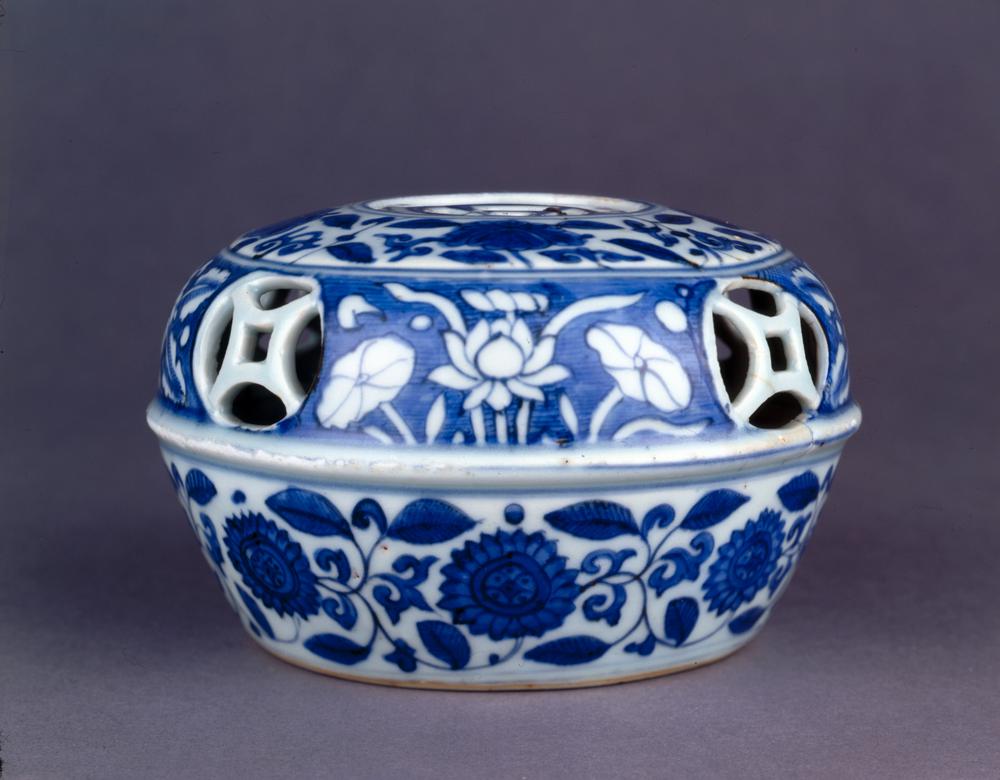Period:Unknown Production date:5thC-6thC
Materials:plaster, gold (probably gold leaf),
Technique:painted
Dimensions:Height: 34.50 centimetres Thickness: 4.20 centimetres (maximum) Width: 60 centimetres
Description:
Convex-sectioned fragment of polychrome wall painting. An animal, possibly wolf-headed, deity. When found, the original painting was preserved to a height of four feet. The animal is shown in left profile with open mouth, large fangs and large pointed ears. In his left hand he appears to carry an object, possibly a weapon (a blade with trefoil facetting?, a vajra?). The image originally had four arms; the upper pair are preserved here. The large halo with wide brown border about the head of the figure is largely lost. At the top of the animal’s head Stein said that he was able to identify a human skull. This attribute has been lost though something like it is just visible in the published photograph of the painting when still in situ (Serindia IV, fig. 328 and scanned into this Merlin entry). The figure wears an elaborate red and blue coat, large, circular earrings and possible bangles (the black stripes drawn on his lower forearms). At the neck of the animal are traces of what is likely to be gold leaf.
IMG
![图片[1]-wall-painting BM-2004-0510-0.1-China Archive](https://chinaarchive.net/Unknown/Paintings/mid_00015554_001.jpg)
![图片[2]-wall-painting BM-2004-0510-0.1-China Archive](https://chinaarchive.net/Unknown/Paintings/mid_00015555_001.jpg)
![图片[3]-wall-painting BM-2004-0510-0.1-China Archive](https://chinaarchive.net/Unknown/Paintings/mid_00017117_001.jpg)
![图片[4]-wall-painting BM-2004-0510-0.1-China Archive](https://chinaarchive.net/Unknown/Paintings/mid_01184349_001.jpg)
Comments:Stein’s view was that this image was of a rat-headed deity famous for having save Khotan from an attack by the Huns (Serindia III, 1277).The face depicted here is not at all rat-like and is more similar to that of a dog or a wolf. Notwithstanding this view, the painter may well have intended the depiction here to be that of a fierce rodent god, though not an anatomically very accurate rendering of it. The rat-king deity is depicted on a wooden panel (1907.11-11.68) from Dandan-oilik and Stein is reminded of this image when considering the identity of the Tarashlik image. The animal-headed deity in our wall painting is associated in situ at Tarashlik.i with a painting of a richly dressed woman, possibly associated with silkworm cocoons and mulberry leaves (according to Stein) and similar to the female figure on a painted wooden panel from Dandan-oilik (1907.11-11.73). This person is usually thought to be the Chinese princess who brought silkworms to Khotan. The precise identity of the animal-headed figure in the Tarashlik panel remains unclear, however, though the argument for the rat-deity view seems compelling in the absence of any other historical or iconographical data.
Materials:plaster, gold (probably gold leaf),
Technique:painted
Dimensions:Height: 34.50 centimetres Thickness: 4.20 centimetres (maximum) Width: 60 centimetres
Description:
Convex-sectioned fragment of polychrome wall painting. An animal, possibly wolf-headed, deity. When found, the original painting was preserved to a height of four feet. The animal is shown in left profile with open mouth, large fangs and large pointed ears. In his left hand he appears to carry an object, possibly a weapon (a blade with trefoil facetting?, a vajra?). The image originally had four arms; the upper pair are preserved here. The large halo with wide brown border about the head of the figure is largely lost. At the top of the animal’s head Stein said that he was able to identify a human skull. This attribute has been lost though something like it is just visible in the published photograph of the painting when still in situ (Serindia IV, fig. 328 and scanned into this Merlin entry). The figure wears an elaborate red and blue coat, large, circular earrings and possible bangles (the black stripes drawn on his lower forearms). At the neck of the animal are traces of what is likely to be gold leaf.
IMG
![图片[1]-wall-painting BM-2004-0510-0.1-China Archive](https://chinaarchive.net/Unknown/Paintings/mid_00015554_001.jpg)
![图片[2]-wall-painting BM-2004-0510-0.1-China Archive](https://chinaarchive.net/Unknown/Paintings/mid_00015555_001.jpg)
![图片[3]-wall-painting BM-2004-0510-0.1-China Archive](https://chinaarchive.net/Unknown/Paintings/mid_00017117_001.jpg)
![图片[4]-wall-painting BM-2004-0510-0.1-China Archive](https://chinaarchive.net/Unknown/Paintings/mid_01184349_001.jpg)
Comments:Stein’s view was that this image was of a rat-headed deity famous for having save Khotan from an attack by the Huns (Serindia III, 1277).The face depicted here is not at all rat-like and is more similar to that of a dog or a wolf. Notwithstanding this view, the painter may well have intended the depiction here to be that of a fierce rodent god, though not an anatomically very accurate rendering of it. The rat-king deity is depicted on a wooden panel (1907.11-11.68) from Dandan-oilik and Stein is reminded of this image when considering the identity of the Tarashlik image. The animal-headed deity in our wall painting is associated in situ at Tarashlik.i with a painting of a richly dressed woman, possibly associated with silkworm cocoons and mulberry leaves (according to Stein) and similar to the female figure on a painted wooden panel from Dandan-oilik (1907.11-11.73). This person is usually thought to be the Chinese princess who brought silkworms to Khotan. The precise identity of the animal-headed figure in the Tarashlik panel remains unclear, however, though the argument for the rat-deity view seems compelling in the absence of any other historical or iconographical data.
© Copyright
The copyright of the article belongs to the author, please keep the original link for reprinting.
THE END
![[Qing Dynasty] British female painter—Elizabeth Keith, using woodblock prints to record China from the late Qing Dynasty to the early Republic of China—1915-China Archive](https://chinaarchive.net/wp-content/uploads/2022/11/image-191x300.png)




